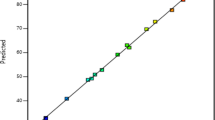Abstract
Counter-current chromatography (CCC) is a low pressure, liquid–liquid chromatographic technique which has proven to be a powerful purification tool for the high-resolution fractionation of a variety of active pharmaceutical compounds. The successful integration of CCC into either existing or new manufacturing processes requires the predictable purification of target compounds from crude, fermentation-derived, feed streams. This work examines the feasibility of CCC for the purification of fermentation-derived erythromycin A (EA) from its structurally and chemically similar analogues. At the laboratory scale, the effect of feed pre-treatment using either clarified, forward extracted (butyl acetate) or back extracted broth on EA separation was investigated. This defined the degree of impurity removal required, i.e. back extracted broth, to ensure a reproducible elution profile of EA during CCC. Optimisation and scale-up of the separation studied the effects of mobile phase flow (2–40 ml⋅min−1) and solute loading (0.1–10 g) on the attainable EA purity and yield. The results in all cases demonstrated a high attainable EA purity (>97% w/w) with throughputs up to 0.33 kg⋅day−1. Secondly, a predictive scale-up model was applied demonstrating, that from knowledge of the solute distribution ratio of EA (KEA) at the laboratory scale, the EA elution time at the pilot scale could be predicted to within 3–10%, depending upon the solute injection volume. In addition, this study has evaluated a “fractionation diagram” approach to visually determine the effects of key operational variables on separation performance. This resulted in accurate fraction cut-point determination for a required degree of product purity and yield. Overall, the results show CCC to be a predictable and scaleable separation technique capable of handling real feed streams.







Similar content being viewed by others
References
Booth AJ (2003) Process design and scale-up of counter-current chromatography for the fractionation and recovery of polyketides antibiotics. PhD thesis, University of London, UK
Booth AJ, Lye GJ (2001) Optimisation of the fractionation and recovery of polyketide antibiotics by counter-current chromatography. J Liq Chromatogr Related Technol 24(11–12):1841–1861
Booth AJ, Sutherland IA, Lye GJ (2003) Modelling the performance of pilot scale counter-current chromatography: scale-up predictions and experimental verification of erythromycin separation. Biotechnol Bioeng 81(6):640–649
Brill GM, McAlpine JB, Hochlowski JE (1985) Use of coil planet centrifuge in the isolation of antibiotics. J Liquid Chromatogr 8:2259–2280
Chen RH, Hochlowski JE, McAlpine JB, Rasmussen RR (1988) Separation and purification of macrolides using the ITO multi-layer horizontal coil planet centrifuge. J Liquid Chromatogr 11:191–201
Davies JL, Baganz F, Ison AP, Lye GJ (2000) Studies on the interaction of fermentation and microfiltration operations: erythromycin recovery from Saccharopolyspora erythraea fermentation broths. Biotechnol Bioeng 69:429–439
Harada K-I (1996) Separation of complicated antibiotics by high-speed countercurrent chromatography. In: Ito Y, Conway WD (eds) High-speed countercurrent chromatography. Wiley, New York, pp 301–319
Marston A, Hostettmann K (1994) Countercurrent chromatography as a preparative tool—applications and perspectives. J Chromatogr A 658:315–341
Ngiam SH, Zhou YH, Turner MK, Titchener-Hooker NJ (2001) Graphical method for calculation of chromatographic performance in representing the trade-off between purity and recovery. J Chromatogr A 937:1–11
Oka H, Harada K, Ito Y, Ito Y (1998) Review—separation of antibiotics by counter-current chromatography. J Chromatogr A 812:35–52
Richardson P, Hoare M, Dunnill P (1989) Optimization of fractional precipitation for protein purification. Chem Eng Res Des 67:273–277
Richardson P, Hoare M, Dunnill P (1990) A new biochemical engineering approach to the fractional precipitation of proteins. Biotechnol Bioeng 36:354–366
Sherwood D (1996) GMP and quality control. In: Verrall MS (ed) Downstream processing of natural products. Wiley, Chichester, England, p 329
Sutherland IA, Muytjens J, Prins M, Wood P (2000) A new hypothesis on phase distribution in countercurrent chromatography. J Liquid Chromatogr Related Technol 23(15):2259–2276
Sutherland IA, Brown L, Graham AS, Guillon GG, Hawes D, Janaway L, Whiteside R, Wood P (2001) Industrial scale-up of countercurrent chromatography: predictive scale-up. J Chromatogr Sci 39:21–28
Wang-Fan W, Küsters E, Lohse O, Mak C, Wang Y (1999) Application of centrifugal counter-current chromatography to the separation of macrolide antibiotic analogues. I. Selection of solvent systems based on solubility and partition coefficient investigations. J Chromatogr A 864(1):69–76
Acknowledgements
Financial support from the Biotechnology and Biological Sciences Research Council (BBSRC) is gratefully acknowledged. AJB would also like to thank the BBSRC for the provision of a PhD studentship.
Author information
Authors and Affiliations
Corresponding author
Rights and permissions
About this article
Cite this article
Booth, A.J., Ngiam, S.H. & Lye, G.J. Antibiotic purification from fermentation broths by counter-current chromatography: analysis of product purity and yield trade-offs. Bioprocess Biosyst Eng 27, 51–61 (2004). https://doi.org/10.1007/s00449-004-0380-2
Received:
Accepted:
Published:
Issue Date:
DOI: https://doi.org/10.1007/s00449-004-0380-2




